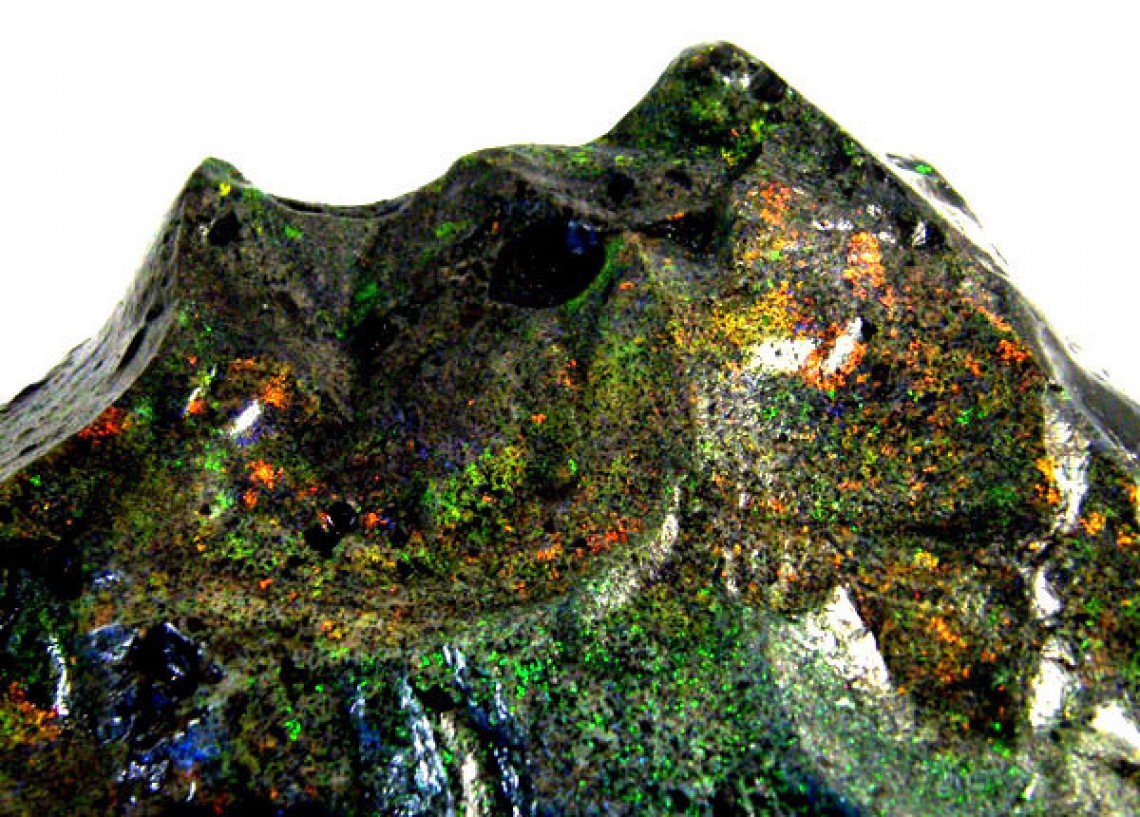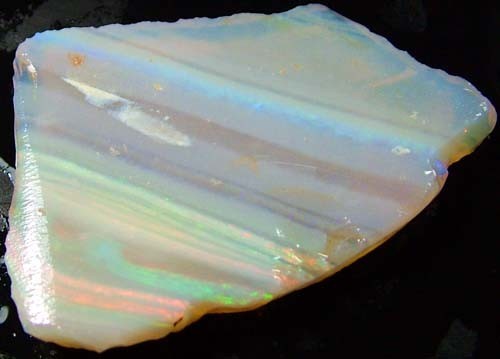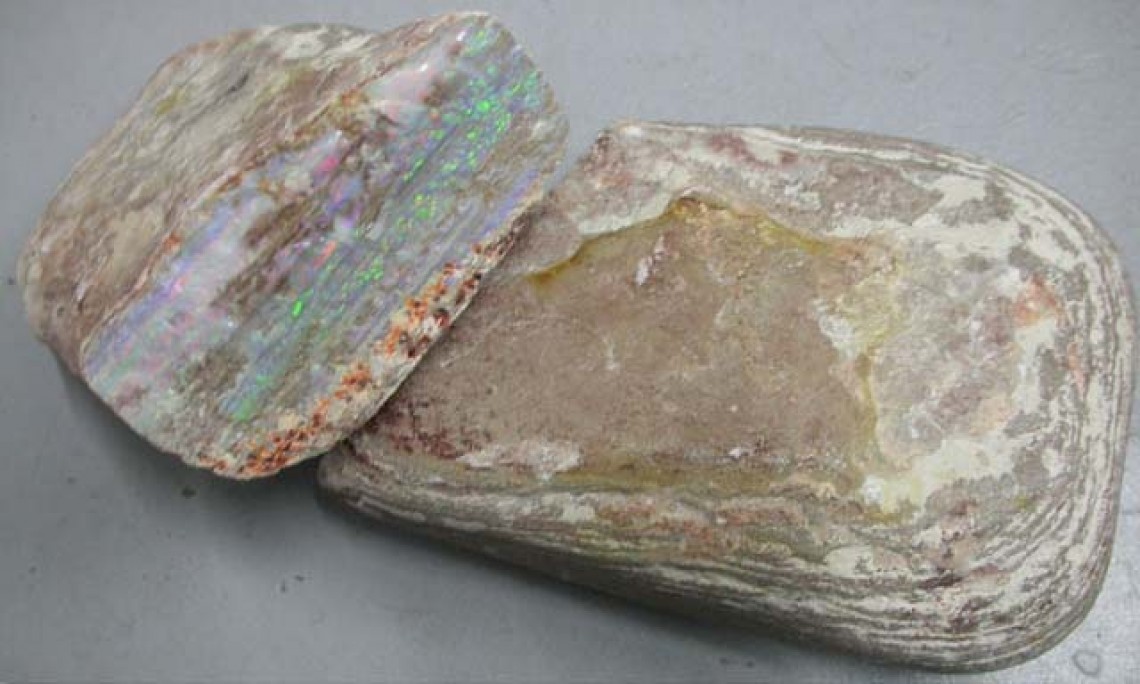History About Andamooka Opal and How To Treat It

[Read Time: 10 minutes]
In South Australia Opal was first discovered at Andamooka during the 1930’s. The first Andamooka Opal was discovered by Sam Brookes and Roy Sheppard. Caught in a thunderstorm they sheltered under a tree when a pretty rock caught the corner of their eye. Smaller deposits were exposed afterwards including Lambina during 1930 and Stuart Creek in 1947. Opal at Andamooka exists in the thin marine ‘Bulldog Shale’ which is the significant portion of the Marree Subgroup of the Early Cretaceous period.
Summary
Andamooka is one of the oldest known opal fields in Australia
Opals from Andamooka have been used in the Queens Jewelry
Andomooka Opal can be treated with sugar to turn it black and improve the Opal play of color.

Famous Andamooka Opal
Andamooka Opal is also known as the “Queen’s Opal”. It was cut and set into an 18 carat palladium choker band in 1954. It was presented to Queen Elizabeth II on the event of her first authorized state trip to Australia. Nowadays the necklace and earrings are considered a significant part of Queen Elizabeth II’s special crown jewels. The final Opal weighed 203 carats.

Discovered during 1930, Andamooka is considered a one of Australia’s most prominent opal fields. It has generated some of the most attractive pieces or sets of opal such as “The Andamooka Matrix Opal”, which is also referred as “The Queen’s Opal” mentioned above. The word Andamooka is derived from an Aboriginal name, meaning ‘Large Waterhole’. It is situated 600 kilometres north of Adelaide, and is the only Australian city where none of the streets are named.

Andamooka Opal Treatment
The Andamooka opal mines are well-known for producing light opal, which compromises white, crystal opal, it is sometimes referred as “milk” opal.
Matrix Opal is a permeable opal, which originates from Andamooka, South Australia. A variety of boulder opal also appears in Andamooka. Most of the rock in the surrounding area is quartzite and so sometime the Opal forms in between this very ha rd rock. These are referred as the “painted ladies”.

Andamooka matrix opal is regularly treated to improve the colour by creating a black body using black carbon. This treatment involves a chemical treatment that is applied to the entire stone. When it comes out of the earth, it can look quite pasty, but by treating it by means of a carbon dye method it ultimately looks like a more appealing Opal.
Once it is totally treated, it is known as Andamooka treated matrix opal. With a rich solution of sugar with water, it is usually followed by a phase of simmering in a bath with a resolute sulphuric acid. The sugars pierce in the limestone matrix, and then the acid cooks it and that turns the white sugar around the pockets of opal into a black carbon. The outcome is that the darkened matrix encloses the pockets of opal, which does not diffract light. Some miners took the originals and sold them overseas as Lightning Ridge Black opal. After the scam was revealed, there developed a time when no one would purchase treated matrix. But the remarkable colours and rich black matrix of the best gemstones actually does present the attributes that make the Lightning Ridge black opal famous. Treatment of these matrix stones involves a moderately simple method of processing the stones.
 Sometimes an epoxy glass resin is used to give the stones a beautiful shine. You can find it here.
Sometimes an epoxy glass resin is used to give the stones a beautiful shine. You can find it here.

Andamooka Dinosaur Bones
Dinosaur fossils and bones have been found in Andamooka and many are now in museums. Australian dinosaurs are from 100 to 240 million years old which puts them in the Jurassic and Cretaceous periods. Many countries have dinosaur bones but only in Australia have opalized dinosaurs been found as opalized fossil.
Andamooka Opal Price
Matrix opal can be quite reasonably priced, which is different with the authentic black opal. For the buyers, they should be aware with some opal dealer whether you are purchasing an authentic black or Andamooka matrix opal stones. 
How To Treat Andamooka Matrix Opal
The equipment used is very basic. For the heating, use an old electric frypan with a thermostat control. It is very important not to overheat the opal as it can fracture when too hot.
Place a mixture of 1 cup of sugar (white or brown doesn’t seem to make any difference) in a pyrex or other heat resistant bowl with an equivalent amount of water and heated until the sugar is dissolved.
Set the frypan to about mid-range for the heating process. The pyrex bowl can be placed directly onto the frypan.
Before treating the matrix opal it needs to be cut and shaped and sanded but not polished. The opal should be dried thoroughly by light heating to remove any moisture from the fine pores in the stone. Avoid touching the stone with your fingers as oil from your fingers can affect the treatment.
The stone or stones are then placed in the sugar syrup solution and cooked for 8 hours plus. The time of cooking is a bit of a guess and depends on the porosity of the stones. Very porous matrix will absorb the sugar solution much more quickly than dense matrix. I do not know how to assess how long it will take but 8 hours seems a good start.
After cooking let them cool down. It may be necessary during this stage to add some more water to the sugar solution if it becomes too thick due to evaporation due to the cooking process.
THE NEXT STAGE IS A VERY DANGEROUS ONE AS IT INVOLVES THE USE OF HIGHLY CONCENTRATED SULPHURIC ACID. THIS IS VERY CORROSIVE AND THE FUMES CAN ALSO BE DANGEROUS.
Use 93% sulphuric acid obtained from a chemical supplier.
Place a small quantity in a pyrex bowl and place it in the frypan . The frypan is in a well ventilated shed.
When putting the acid into the bowl it is recommended to use rubber gloves and eye protection as the acid will badly burn you if it splashes onto your skin, so do be careful. Also never pour the acid into water as it will react violently and could splash you. Preferably use a mask also.
The stones are then carefully removed from the sugar solution with plastic tweezers (not metal ones as they will react with the acid) and then carefully placed in the acid after letting excess sugar solution drip off the stones. Don’t attempt to wipe the stones at this stage. The stones can then be cooked in the warmed acid for two hours plus. At this stage they will have changed colour. They can then be removed carefully with plastic tweezers and should be placed in another bowl with a weak sugar solution or a solution of bicarbonate of soda. This is to neutralise the acid.
After a few minutes they can then be admired although there is still the final polishing to be carried out. While wet you will see the amazing transformation that has taken place. The colors of the opal will now be clearly showing.
If the matrix was quite dense you should now be able to polish the stone. It is better not to use cerium oxide or tin oxide as the polishing compound can get into the pores and be seen as tiny white spots which can mar the surface. Use a leather lap with 50,000 grade diamond for the polishing.
Extra care needs to be taken not to apply too much pressure as this will generate a lot of heat and could crack the stone. The more porous matrix may not polish at all. If this is the case the surface can be covered with liquid glass to produce a highly polished surface. I will discuss this treatment in a different post.
Don’t forget to dispose the acid carefully. Add the acid to water very slowly and then bury it in the garden when it is very diluted. Do not add water to the acid as it will splutter and could easily splash onto you causing harm. If it does, liberally wash the affected area with water. If anyone has any comments on this treatment or any alternative treatments please feel free to comment. This process had worked for me and have some very beautiful stones which look very much like quality black opal and have cost very little in comparison.
Shop For Andamooka Opal
Was this article helpful?
13 people found this article helpful
Wayne Sedawie
- Written - 18th Jan 2013
- Edited - 3rd Jan 2023
Comments
Information supplied by an Australian Opal cutter who has treated fairy opal and Andamooka matrix
TREATMENT FOR FAIRY OPAL AND ANDAMOOKA MATRIX WITH SUGAR ONLY.
MATERIALS
250 grams glucose, white castor sugar, pot or pressure cooker, plastic tweezers.
STEPS
-Pre shape the material
- Thoroughly dry the material in oven sun or hairdryer.
- Put water in pot on low temperature and add glucose and castor sugar. DO NOT BOIL.
-Place warmed stones into warm solution and cover the stone with liquid.
-leave on low temperature for 24 hours but DONT BOIL.
-Remove with tweezers and let cool. Use a paper town to wipe away access.
The next step is to carbonize the sugar in the stone. Place the stones on a metal or Pyrex dish and place in a kiln at 600 degrees for one hour. This will burn or carbonize the sugar in the stone.
_When the stones have cooled clean on a grinding wheel.
Remember to take all precautions with gloves and mask and clothing with good ventilation.
This is a natural product so results may vary a bit due to how porous the sandstone is. Some material will have to be treated a few times to get good results. You can also experiment with various temperatures as i like to cook with lower temperatures.
Remember to have experiment and have fun!
Also you can boil your stones in sugar water, then dry your stones on low in an oven for half hour, then soak in vegetable oil over night and then wrap them in alfoil and place on an open flame until all the oil is burnt off (you will know when done as the flames stop). Then your ready to epoxy and sand to polish. Black shoe polish applied to the finished stone also helps the shine and might cover fine scratches apparently. Pretty drawn out process but well worth it if you master the epoxying/polishing process which I have not so I just buy mine from a reliable source at a very good price. Peace to the world. Sincerely.

Did you know?

Opal Auctions Verified Sellers


















